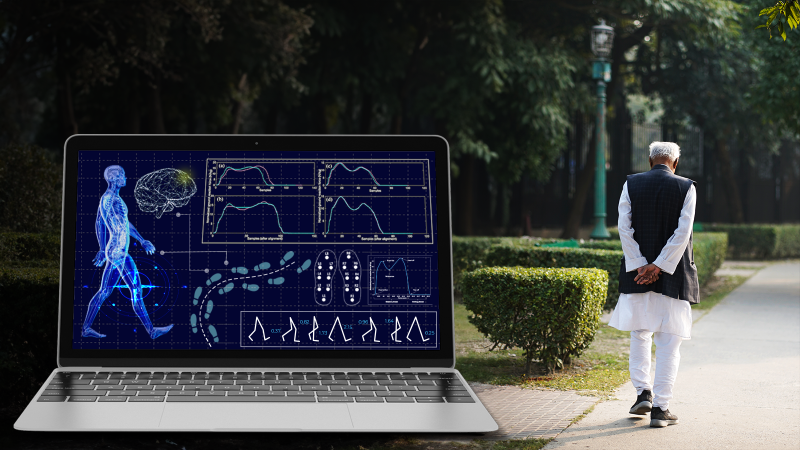
Parkinson's disease (PD) is a neurodegenerative disorder affecting neurons in the brain. Named after James Parkinson, who first described the condition in 1817, PD is characterised by the progressive degeneration of dopamine-producing neurons in the brain called dopaminergic neurons. Dopamine is a hormone and a neurotransmitter – a chemical that allows neurons to talk to each other. Dopamine plays a crucial role in coordinating controlled movements of the muscles, as well as regulating other functions like mood, memory, sleep, and learning. A decrease in dopaminergic neurons, and consequently in dopamine, can affect an individual’s movement as well as other functions.
An insidious disorder, early symptoms of PD are particularly hard to spot. Many individuals remain undiagnosed until symptoms become conspicuous and severe, making treatment far more challenging at this advanced stage of PD. The hallmark symptoms of Parkinson's disease include tremors, rigidity of muscles, slowness of movement, and postural instability. As the disease progresses, individuals may also experience difficulties with balance, coordination, and a range of non-motor symptoms such as sleep disturbances, mood changes, and cognitive impairment.
The latent signs of PD start intermittently, and progressively become more consistent as the disease develops over time. By the time symptoms manifest, around 50% to 80% of dopaminergic neurons have already degenerated. This makes the initial diagnosis notoriously difficult but remarkably crucial in mitigating the negative impacts later on.
Now, in an advancement in early PD detection, researchers from the Indian Institute of Technology, Bombay (IIT Bombay) and Monash University, Australia have proposed an innovative method that allows the earliest and simplest way to detect PD, even before the patients show any obvious symptoms. The study proposes analysing slight differences or inconsistencies in the walking patterns of individuals and using well-established mathematical tools to detect PD.
PD primarily manifests as a loss of control over body movements or motor functions such as walking, talking, and gripping objects. Based on this knowledge, the researchers hypothesise that there could be subtle and intermittent differences over time in the way individuals affected by PD walked. They analysed the walking pattern, known as 'gait' data, from patients using an algorithm called Dynamic Time Warping (DTW). DTW is an algorithm that allows comparison between two temporal sequences (events happening over time), like a person walking, writing or speaking.
“DTW in general is an algorithm to find similarity between two temporal sequences which may vary in speed. For eg. the same person walking at different speeds,” explains Ms. Parvathy Nair, a doctoral student at the IIT Bombay-Monash Research Academy and the lead author of the study.
She was guided by Prof. Maryam Shojaei Baghini, a professor at IIT Bombay, and co-advised by Prof. Hoam Chung from Monash University.
While comparing gait data using DTW, any minor, intermittent differences between any pairs of cycles of the same event, show up as a high difference compared to other pairs.
“A disturbed gait is the most common, debilitating symptom of PD. Hence, we developed a generic algorithm (DTW) to detect the intermittent gait disturbances that may appear due to any early-stage symptom,” adds Ms. Nair.
Next, using a mathematical technique called K-means clustering, the data is organised into clusters, which allows for the extraction of identifiable features for each individual being tested based on the DTW data.
Ms. Nair explains, “These final features are fed to a simple logistic regression (a statistical model) to easily and successfully detect early PD symptoms, which was reported as challenging using conventional statistical features”. She adds, “In our algorithm, the feature extraction using DTW and K-means is performed separately for each subject to avoid any effects or outliers due to variations in the style and speed of walking in different people”.
The researchers tested their model on a total of 166 participants, where 83 were in the early stages of PD, 10 participants were in the middle stages, and 73 were healthy individuals considered as the control group. They used gait data of the patients from three different studies which has been compiled in a database named Physionet database. They found that their model predicted PD in the test subjects at an impressive 98% prediction accuracy, where 89% of the patients were in the early stages of PD. Moreover, since the technique used is generic, the researchers believe that the method could also be used to detect other neurodegenerative disorders, where motor functions are affected.
“There are still many early motor symptoms of PD, which are not visually observable but correlate with many fine details of the human body movements. Choice of the right function and the rightly positioned sensors are the key and are a part of the ongoing research. Outputs of such wearable sensors, to be collected on a timely basis along with the repeatability pattern analysis, will open more avenues towards early detection of PD. We are continuing the research in this direction,” remarks Prof. Maryam Shojaei Baghini.
The key to combating Parkinson's lies in early detection. Though the disease is incurable, early diagnosis can assist medical practitioners in initiating the right treatment procedures, thus reducing the severity of symptoms in later stages. In addition, early treatment could potentially help in preventing the manifestation of classical motor symptoms, enhancing the patient's quality of life and substantially lowering treatment costs.






